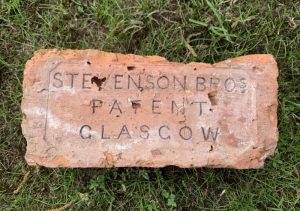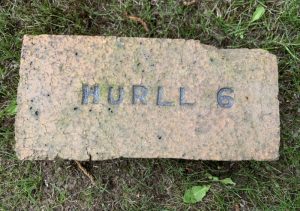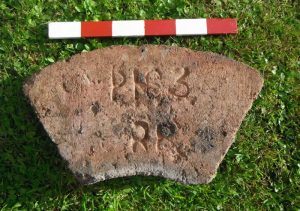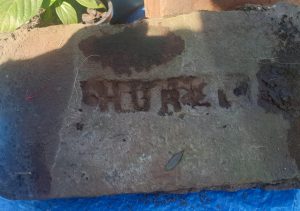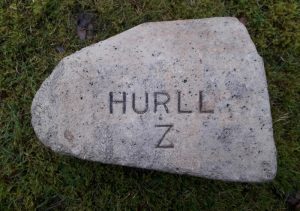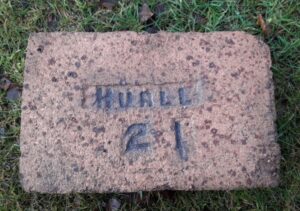Chapter Five – Brick and Field drain Works – Written by Eric Flack and reproduced by kind permission. It is a fascinating read.
Another local industry was the manufacture of bricks. Three of the local brickwork’s produced terracotta type bricks and field tiles or drains in updraught kilns from locally dug red clay. These were Horn’s which was located at the Elderslie Dry-dock at the foot of the Dyke Road and the Garscadden Brick and Tile Works, which was owned by Horn’s and latterly by Stevenson Brothers. This was located on the opposite side of the canal from Keal Drive and Avenue and had an extensive pit from which red clay was dug and then pushed by hand into wooden or metal boxes to make terracotta type bricks in updraught kilns. They also had a clay pit on the left side of Garscadden Road towards Great Western Road. In the 1860 Ordnance Survey name book for New Kirkpatrick, it notes the following. “Blairdardie Brick and Tile Works. Robert Horn, brick keeper. This place has been used for making bricks and tiles for about 20 years. It is of a permanent nature. It belongs to Garscadden Estate the property of Mr Colquhoun of Killermont”.
Terracotta bricks are considered superior to the traditional Scottish brick due to the firing process producing higher temperatures, which produced good weather resistance. The Garscadden Brickworks latterly used coal from the Baljaffrey Pit in Bearsden, which closed in 1910. These bricks are marked “Horns” and then “Stevenson Bros Drumchapel. Glasgow”.
Stevenson’s Garscadden Brickworks closed in 1916 when the red clay deposits become exhausted. The clay pit was used as a refuse coup by Clydebank Town Council with a small fee for each load couped being paid to Garscadden Estate.
Thomas Gilmore whose father ran the Kilchattan Brick and Tile Works on Bute opened the Drumchapel Brickworks. He paid a lease of £60 per year to the Cowdenhill estate. This lease was terminated on Whitsunday 1906 due to most of the suitable brick making material being used up. It operated between Essenside Avenue and the railway next to Drumchapel No 2 colliery. This brickwork used red plastic clay dug out of the ground at this location to produce field drains (field tiles) and terracotta bricks in an updraught kiln. After Thomas Gilmour gave up the lease the brickworks were re-opened for a short time by Kings. It is understood that the manager was killed when a railway wagon door, which he was opening, fell on him. The works shut soon after this. Gilmours bricks are marked “G & G Glasgow”. Other smaller brickworks exploiting the red clay were Hutton’s Brickfield run by William Hutton in 1881 and Cloberhill Brickfield. Both of these were located on the south bank of the canal between the Bard Avenue bridge and the bridge at Blairdardie Road.
Peter and Mark Hurll opened the last brickwork’s in the area in 1903 adjacent to the railway on land now occupies by Edrington Holdings and installed a Hoffman Continuous Kiln to produce Scottish common bricks. They installed a double-track two-foot gauge tramway to Peel Glen on the trackbed of the former Garscadden Private Tramway and built an extension of the tramway to a loading dock on the canal. An export business flourished with puffers carrying Drumchapel bricks to the Western Isles and Colerain in Northern Ireland. The tramway passed under Great Western Road adjacent to the Duntreath Avenue flyover. The brickwork’s used the black blaes from the mine spoil tips in the Peel Glen area. The blaes was dug out and loaded into hutches, which were then screwed down onto a slow-moving continuous steel hawser powered by a large flywheel driven by a steam engine at the brickworks.
On 27th Nov 1908 Mark Hurll, due to the lack of demand, wrote to Rev Campbell Colquhoun of Garscadden House to ask him whether he would agree to allow Hurlls a period of two or three years to make up the fixed rent of £100 per year. Mr Hurll was sad that they were loading bricks at Garscadden both in railway trucks and on the canal in order to make up the fixed rent of £100 per year. On 4th March 1910 due to the poor trade Hurlls agreed not to re-insure the Garscadden works engine. On 31st March 1911, trade had not improved and they closed the Knightswood Brickworks. On 7th April 1911, Mark Hurlls salary was £300 per year and John Hurlls was £350. On 13th August 1918, it was noted in a letter to the NB Railway Company that the existing brickwork siding cannot be worked meantime as the cables worked from the steam plant in the brickworks which used to draw wagons into the works siding from the NB railway siding is now disused. It was also noted that there was a considerable quantity of bricks lying at the works which were at present closed down. However, the company was being pressed for delivery of bricks from the Garscadden Works for urgent orders. A small length of hutch tramway was laid from the brickworks to the NB railway siding, which could only accommodate four wagons, in order to load bricks. A nominal rent of ten shillings per year was paid to the NB Railway Company for this tramway. The hutch tramway was removed on 26th May 1921. On 20th June 1920, the unsatisfactory state of the Garscadden works due to engine trouble was noted and it was agreed to replace the steam engine with an electric motor. The works were put on a care and maintenance basis due to low demand. On 22nd September 1921, it was agreed to work as quickly as possible at Garscadden to refurbish the works with the erection of a new gangway into the mill house so as to be able to store blaes for one or two days work. Hurlls were anticipating large orders for bricks from the new housing schemes being proposed throughout the city. On 22nd September 1921, it was agreed to re-open the Garscadden Works after hearing that the contract for the Knightswood housing scheme had been fixed. It was agreed to raise the height of the chimney by 20 feet and put a lightning conductor on it. On 24th October 1923, it was agreed to write to the London and North Eastern Railway Co and ask their permission for the construction of a footpath for the use of their workers at the bottom of the fencing from the public road on the west side of Drumchapel Station (Garscadden Road ) to end at the brickworks. On 2nd September 1924, the blaes bings at Castlehill (top of Peel Glen) purchased for £250 with a halfpenny per ton way leave paid to Garscadden Estate. On 22nd December 1924, a blaes drier was ordered from William Rowan and Sons. On 2nd July 1925, it was agreed to supply Messr’s McDonald and Niven with 2 million bricks per year (for Knightswood) at a price of fifty-two shillings and sixpence delivered. On 3rd September a contract was agreed to supply John McCandlas of Colerain. N.Ireland with bricks. These bricks were loaded onto puffers using a loading dock at lock 36. A Proctor mechanical stoker was installed at a cost of £250 in November 1925. In May 1927 it was agreed to sell 2,500,000 bricks per year to McTaggart and Mickel at forty-seven shillings and sixpence per thousand. Sale of oldest bing in Peel Glen at two shillings per ton if it could be got. Due to demand, it was agreed to install a new Hoffman kiln at Garscadden. In June 1927 in connection with the construction of Knightswood, it was agreed to supply John McDonald with 15,000 bricks per day at a cost of fifty-two and sixpence delivered on-site.
Mark Hurll had bought South Hutcheson farm to use the coal bings that were on the land from Garscube Estate. In July 1927 it was agreed to buy South Hutcheson Farm from Mark Hurll for £2,000. The tenancy of Mr Chapman who ran it as a dairy farm with a local milk round was to continue. This farm was at the top of Ladyloan Avenue adjacent to Lochgoin Avenue. In March 1939 it was noted that Garscadden Estate had been sold to Glasgow Corporation. A going rate of £60 to £120 per acre had been the agreed rate for the sale. It was agreed to sell South Hutcheson Farm to Glasgow Corporation for £7,600 on 19th June 1939. As a result of this sale on 13th June 1940 Hurlls were able to pay off all the arrears of preference shareholders from 1st July 1931 to 21st March 1940.
The strong demand for bricks due to new housing schemes had led to the exhaustion of the local black blaes. Efforts to secure supplies from St Flannans pit bung in Kirkintilloch by road and the transport costs to be paid by the Garscadden works were agreed. On 18th July 1939 due to the strong demand for bricks at Garscadden, it was agreed to increase working to 54 hours per week. On 16th October in exceptional circumstances. On 22nd February 1940, the Garscadden night shift was stopped due to difficulties in operating in wartime with restricted lighting. Day shift to be extended to a 54-hour week. On 10th July 1941, the supply of blaes and raw materials was causing grave concern. A lot of defective bricks which had cracked on firing were being produced due to the poor quality of the local blaize. It was agreed not to build air-raid shelters until the continuity of working was secured. On the nights of the Clydebank Blitz on 13th and 14th March 1941 the workers at the brickworks took shelter in the Garscadden Road School. On 18th October blaes from Garscube Colliery was being supplied at 6d per ton. The additional transport costs and wartime fuel restrictions made the production of bricks uneconomic and the works were mothballed in November 1941. Most of Knightswood and Old Drumchapel were built with Hurll’s bricks. These bricks are marked “P&M Hurll” also “P&M Hurll, Glasgow”. Some have the “S” turned the wrong way! Thus the works closed when it proved impossible to manufacture suitable bricks from the blaes left in the local spoil tips and the high transport costs along with wartime fuel restrictions making road transport of blaes uneconomic. Some of the blaes in the spoil tips in Peel Glen had burnt and turned red due to internal combustion caused by the high level of coal matter the blaes contained. Tinkers, who used to camp in the Peel Glen area, used to go round the doors in the Bearsden and Old Drumchapel area selling loads of this material from old army lorries for use on garden paths and driveways. Similar material is ground through screens and is still used as the basis of clay tennis courts.
After the brickworks closed down in November 1941 the works were used to store ammunition. A railway loading bay was built and a barrage balloon flew over the works, which by this time were fenced off with barbed wire to a height of about 15 metres. The barrage balloon once broke its moorings and floated away!
In 1945 Hurlls wrote to the Garscadden Estate factors regarding re-opening the brickworks and using blaize from a bing at Castlehill. Garscadden Wood. In 1951 because of a shortage of home-produced bricks required in the construction of the new housing estate in Glasgow the Corporation of Glasgow Housing Committee approved the purchase of two shipments of Belgian wire cut bricks. A total of 400,000 bricks were bought at a cost of £13.50p per 1,000 delivered to the building site. The total cost was £5,4000. The cost of these bricks was almost double the cost of home-produced bricks. Due to the scarcity of building bricks every available brickworks in Scotland was working flat out to meet demand. In 1951 the Alexandra Transport Company (part of the Tilcon group) bought the Garscadden Works. Refurbished the Hoffman kilns at Hurll’s Brickworks and re-opened the brickworks. For a time they used some local blaes from the mine spoil tip at Castlehill adjacent to Gascadden Woods next to Bearsden Golf Course. However, most of the blaes was brought in by lorry from the Cadder Area. The bricks were used in the construction of Drumchapel. In 1957 the brickwork’s closed, the land was cleared and is now occupied by Edrington Holdings. The only traces of the mining industry left in the Drumchapel area are the locally produced bricks with the name of P&M Hurll, Stevenson, Horne, Gilmour marked (G&G), King and in the 1950’s ATC on them. So look out for these. There is an old coal pit air ventilation shaft still visible, on the left-hand side, at the top of Peel Glen road. Also on the left side of Peel Glen Road at its junction with Bearsden Road are the remains of an old pit. On the left-hand side at the foot of Peel Glen Road facing a mine adit can still be seen. This adit drained water from the pit at the top of Peel Glen. The foul water from it, heavily polluted with red iron oxide, was drained across the Peel Glen burn in a pipe into a small drain which led to the Cleddans Burn. Part of this drain is still visible. The residents of the old grey stone miners row in Peel Glen and the residents of the Drumchapel row used the Peel Glen burn as a clean water supply. It was thus called “the healthy burn”
One interesting thought is that the iron plate Railway Bridge in Garscadden Road erected in 1858 and manufactured by Sommervail in the Dalmuir Ironworks from iron plate supplied by Bairds Ironworks could be made from locally mined iron! During the general strike in 1926 people from Glasgow and Clydebank used to push old prams to the pit bings and search through the colliery waste for any lumps of coal.
Subsidence associated with this mining activity is a known problem in the area. On Monday, November 7th 1994 a drilling rig attempting to seal Garscadden No3 pit shaft discovered by Glasgow City Council in September at the junction of Lochgoin Avenue and Achamore Road crashed through the tarmac in Achamore Road and fell into the shaft which was estimated to be some 60 metres deep. In November 2002 the Coal Authority were called in to cap the mineshaft of Drumchapel No1 pit which had caved in causing a section of the gardens between numbers 3 and 7 Drumchapel Gardens to disappear into a fairly large hole which proved to be about 90 metres deep!
Below – 29/07/1879 – Glasgow Herald – Advert for the sale of the going brickwork at Cowdenhill situated on the banks of the Forth and Clyde Canal, 4 miles from Bowling and about 2 miles from Duntocher and 1 mile or thereby from Yoker and Clydebank.

1895 – The 1985 publication ‘A survey of Scottish brickmarks’ suggests the works opened at this time and was owned by Thomas Gilmour from the outset.
1899 – 1900 – Thos Gilmour, Brickmaker, Drumchapel Brickworks, Drumchapel, Bearsden, Glasgow.
1903 – Peter and Mark Hurll opened the Drumchapel Brickworks.
20/05/1904 – Belfast News – At Drumchapel Brickworks, near Glasgow, Jas. Frame, a boy of ten, accidentally fell upon a big wheel, which works the endless chain for bogies carrying the slag to the works, and was carried in among the machinery and killed. His body was dreadfully mangled, his neck and both legs were broken, and arm was wrenched from its socket.
21/01/1910 – Milngavie and Bearsden Herald – Local Builders Affairs. William Stevenson, builder and brickmaker and trading inter alia as Bishopbriggs Building and Joinery Company at Bishopbriggs, Glasgow, examined in bankruptcy before Sheriff Balfour in the County Buildings, Glasgow on Monday. Bankrupt stated, in answer to Mr Walter Neilson, trustee, that he started business on his own as a builder in 1874. He took over the Bishopbriggs Company about October 1907. The capital put into that business was all borrowed, and he had since repaid the loan. He was also interested in the firm of Stevenson Brothers and in the Bishopbriggs Brick Company, he had 1000 shares and was a director. These shares had been transferred to the bank in respect of an overdraft on behalf of Stevenson Brothers. His holdings in South African and other companies had also been deposited with the bank against advances. He had an interest in a large number of properties and would supply a note of all transactions of such. The value of the furniture belonging to him in his house at 55 Dixon Avenue was £28 odds, and he had also some furniture of little value in a house of which he was a tenant at Rothesay. Bankrupt accounted for his insolvency owing to the depreciation which had taken place of late in the value of property. The Bishopbriggs Joinery Company had been carried on at a loss. By a creditor – He had been sequestrated before, in the spring of 1889, and got a discharge. He was short of money for the last three or four years. His loss on the brick and joinery business he estimated at about £2000 and the losses on his stock exchange transactions would come about the same amount. The examination was adjourned.
Below – 1911 – Drumchapel Brickworks.

26/08/1932 – Milngavie and Bearsden Herald – Donald Charles Betty, residing at Gordon Street, Clydebank; John Coole, John Knox Street. Clydebank and Andrew Kane, North Street, Clydebank, all sixteen years of age, were before the Sheriff at Dumbarton Tuesday, 23rd August, charged with having broken into a hut belonging to Messrs. Hurll, Brickworks, Drumchapel and stealing a watch and other articles. The lads were put on probation for six months.
19/10/1932 – Edinburgh Evening News – The steamer Faithful, of Methil, loaded with bricks from Drumchapel, Dumbartonshire, for Macbrie, (Isle of Islay) went ashore on rocks off Machrie. She was discharging cargo, and during the gale drove broadside and was lifted onto rocks. The crew of four were saved.
Below – 1933 – Drumchapel Brickworks.

05/05/1933 – Milngavie and Bearsden Herald – Article regarding an accident between a car and a lorry on the Drumchapel Road near Hurll’s Brickworks.
04/03/1937 – Belfast Telegraph – Arrival at the Port of Belfast, SS Spartan from Drumchapel with bricks.
Below – 1939 – Drumchapel Brickworks.

Below – 1944 – 1967 – Drumchapel Brickworks.

1951 – Alexandra Transport Company refurbished P & M Hurlls Hoffman Kilns in Drumchapel. They started production around 1951 and stopped about 1958. Most of Drumchapel was built with these bricks marked ATC. Most of the clay was transported by road from the Cadder area. However, for a short time 1951/52, some old black shale from an abandoned pit between Bearsden Golf course and the back of Drumchapel at Summerhill Road was used to make bricks. Source Eric Flack.







